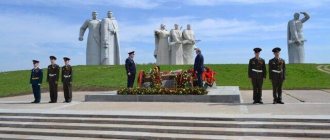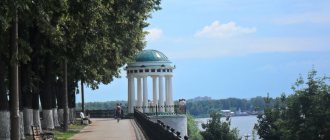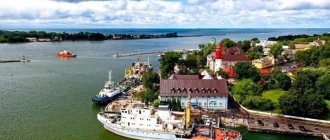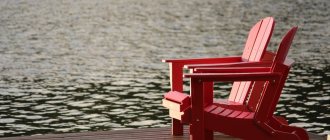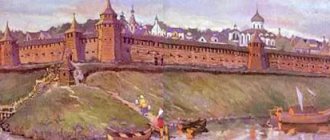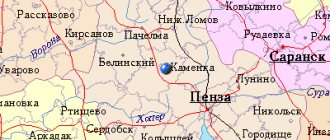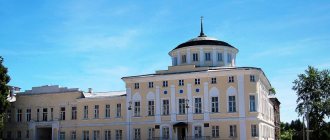The oldest and most cozy town near Moscow, Vereya, has preserved the architectural appearance of past centuries. The most notable sights of Vereya are the Kremlin (fortification), ancient churches, the abolished Spassky Monastery, shopping arcades, a monument to General I.S. Dorokhov, and the building of a district school.
Where to go and what to see in Vereya, the most interesting and beautiful places with photos and descriptions.
A few facts about Vereya
- Vereya is located on the right bank of the Protva River.
- The unusual name of the city, Vereya (with an emphasis on “I”) comes from a Slavic word that means “pillars on which the gates were attached.” The city was considered the western gate of the Moscow principality and the name corresponded to its geographical location.
- The first mention of the city dates back to 1371, when the Lithuanian prince Olgerd went on a campaign against Moscow.
- A Kremlin with wooden walls and towers was built in Vereya - a fortification, of which now only earthen ramparts remain.
- An amazing fact: at the beginning of the 19th century, Vereya was the largest city in the Moscow province; now it has become the smallest city in the Moscow region. This is explained by the fact that the railway bypassed the city.
- In 1812, a French garrison was stationed in Vereya to guard the Smolensk road. The city was liberated by General Dorokhov I.S. with their combat troops and local partisans.
- During the retreat of the French army from Moscow, Napoleon stopped in Vereya. The city was ravaged and burned by the French.
- During the Great Patriotic War, there were fierce battles in the vicinity of Vereya. The city was occupied by German troops for 92 days: from October 18, 1941 to January 19, 1942.
- Tiny Vereya has 6 churches, one of them Old Believer, and several chapels.
- Vereya is a historical settlement of regional significance.
- Vereya is part of the Naro-Fominsk region, located to the west of Moscow, on the border with the Kaluga region.
- In 2022, the central historical square in Vereya was improved, a modern children's playground was built, and a fountain was installed.
- The population of Vereya is about 5.8 thousand people.
- The distance from Vereya to the capital is 120 km, to Ruza, where the Zoya Museum is located - 50 km, to Mozhaisk - 24 km, to the Borodino Field Museum-Reserve - 29 km.
Vereisky Kremlin
Address: st. Karl Marx, 2.
The Vereisky Kremlin or settlement, like any ancient Russian city, is a historical center. The earthen ramparts of the 14th century on the high, steep bank of the Protva River have survived to this day; the fortifications themselves have not survived - they were lost by the 17th century.
On the site of the settlement in 1838, a stone building of public places with service buildings and the prison Vladimir Church (1878) were built; now they house a psychoneurological boarding school. The oldest building of the Vereisky Kremlin is the Nativity Cathedral, built in 1552.
On the territory of the Kremlin there are also mass graves from the times of the Civil and Great Patriotic Wars, a monument to I.S. Dorokhov, a monument to the Liberator Soldier and 2 sculptures of a soldier. The Monument to the Soldier-Liberator is a smaller copy of the famous “Warrior-Liberator” monument in Berlin’s Treptower Park. Author: Evgeniy Vuchetich. Unlike the original, the Berean Warrior does not have a sword in his hands.
How to get there
Bus
From the Park Pobedy bus station, take the direct Moscow-Vereya bus and in two hours you will be in the city center. Buses run quite frequently, but on Fridays in the summer it is better to buy a ticket in advance. Ticket price - 320 rubles.
Electric train
There is no direct train connection between Moscow and Vereya. From the Belorussky railway station you can get to Dorokhovo station (1.5 hours, 240 rubles), then half an hour by regular bus or taxi (500 rubles). You can get to Mozhaisk (2 hours, 288 rubles) and then again by regular bus or taxi. From Mozhaisk to Vereya, regular buses run less often than from Dorokhovo station to Vereya, but a taxi ride will cost a little cheaper.
Cathedral of the Nativity of Christ
Address: Vereya, st. Karl Marx, 2.
The white stone Cathedral of the Nativity of Christ is one of the main buildings of the Settlement. It was erected in 1552 by Prince Vladimir Andreevich Staritsky and was completely rebuilt twice. The multi-tiered bell tower in the classicist style and the refectory were built much later - in 1802. In 1815, the liberator of the city from the French in 1812, Lieutenant General I.S., was buried in this landmark of Vereya. Dorokhov.
In 1918, Dorokhov’s burial place was devastated by the Reds. In 1924, the temple was closed and was used for economic needs. In 1999, it was returned to believers, and restoration of the cathedral began. In 2000, the remains of General Ivan Semenovich Dorokhov were solemnly reburied.
Monument to General Dorokhov I.S.
Address: Vereisky Kremlin
Lieutenant General I.S. Dorokhov was one of the military leaders of the Russian army during the Patriotic War of 1812. He became famous for the fact that he managed to liberate Vereya from the French garrison entrenched in it with a sudden blow from his detachment. And although in 1815 he died in Tula, in his will he asked to be buried in Vereya, which was done by grateful descendants.
Next to the Nativity Cathedral, at the highest point of the Vereisky settlement in 1913, a monument to General I.S. Dorokhov was solemnly erected. Authors: sculptor B.V. Patsiorkovsky and commander of the Sumy Hussar Regiment A.O. Rachmaninov. However, the monument did not stand for long; in 1918 it was shelled and demolished by the Bolsheviks, as “the Tsar’s general.” On the same day, Dorokhov’s grave in the Cathedral of the Nativity was plundered, and the remains were thrown off a cliff.
On the remaining pedestal was installed a huge, plaster head of Karl Marx. The street where the Vereisky Kremlin is located was also named after Marx. In 1941, when the Germans were advancing on the city, the head was torn from the pedestal by a blast wave and broke.
In 1957, on the previous pedestal, a new monument was erected to the hero of the Patriotic War of 1812, liberator of the city of Vereya, Lieutenant General Ivan Semenovich Dorokhov.
Vereya. The smallest city in the Moscow region
A visit to Vereya was inevitable as soon as we went in search of the abandoned pioneer camp “Yasnaya Gorka”. It turned out that these points are located next door.
— The fact that we will see the smallest city in the Moscow region also seemed interesting to us. By the way, Vereya is five times more populated than Chekalin, the smallest city in the Tula region, and is almost 200 years older than it.
The entry sign does not appear to have been updated since 1371. Well, perhaps the “city of military valor” was added in April 2016. What can I say? Patriotic.
It is difficult to say what the five rays converging towards the center mean. It is possible that Vereya was the center of the appanage principality (Vereisky) from 1432 to 1486. The city's coat of arms looks different.
The description reads: “In a silver shield, between two scarlet battlements, with golden seams, there are two scarlet ropes, with half-open gates, the devices of which are golden. In the free part is the coat of arms of Moscow. The shield is crowned with a silver tower crown with three teeth. Behind the shield there are gold hammers placed crosswise, connected by an Alexander ribbon.”
The Slavic word “vereya” means “posts on which gate towels are hung” or “jamb, post at the door and at the gate.” It's a bad city :)) But seriously, it's a gateway city opening to Muscovy from the west. And Vereya, of course, had its own Kremlin, of which at the moment only the ramparts and a map-scheme of “how it was” remain.
In 1625, there were many courtyards in the Vereisky Kremlin: voivode's, boyar's, priest's, and life was in full swing. The Protva River was then navigable, connecting the city with trading cities on the Oka and Moscow rivers. Vereian merchants flourished, trading mainly in hemp oil, garlic, leather, shoe and blacksmith products.
Vereya was also famous for its nets and seines, which were considered the best in all of Russia!
N. Roerich. Overseas guests. 1901. (in the picture, of course, it’s not Vereya, but the mood is conveyed).
In 1725, about 1,500 merchants and townspeople lived in Vereya. In 1784, there were 11 brick factories, 15 forges, 5 factories for the production of malt and leather goods, 2 breweries, and also a factory for the production of paints, tiles and glassware. There were several mills on the Protva River. The city was rich. It lost its status and special state significance only in the 19th century. At the same time, he retained his sincerity and provincial attractiveness. To experience this, you just need to come to Vereya. And I assure you, you will get lost in time and you will definitely be enchanted by this “patchwork town” with cozy hills, path-streets, small houses, fairy-tale cats and kind people.
In 1784, there were 11 brick factories, 15 forges, 5 factories for the production of malt and leather goods, 2 breweries, and also a factory for the production of paints, tiles and glassware. There were several mills on the Protva River. The city was rich. It lost its status and special state significance only in the 19th century. At the same time, he retained his sincerity and provincial attractiveness. To experience this, you just need to come to Vereya. And I assure you, you will get lost in time and you will definitely be enchanted by this “patchwork town” with cozy hills, path-streets, small houses, fairy-tale cats and kind people.
Along Dorokhov Street we walk to the invisible Kremlin, in the center of which rises the Cathedral of the Nativity of Christ. It stands on a high hill above the river. It can be seen from anywhere in the city. He is like a lighthouse to which lost ships rush. Symbolic.
The Cathedral of the Nativity of Christ was founded in 1552 by decree of Ivan the Terrible in honor of the capture of Kazan and as a sign of honor for the Verei warriors during the storming of the city. The cathedral was rebuilt and completed several times. He is still in the scaffolding. Moreover, the bell tower is being restored in “layers” :))) The top is already at the parade - you can see it a mile away! The lower part is in excited anticipation.
In the ancient part of this cathedral, in 1815, our fellow countryman, the hero of the Patriotic War of 1812, Ivan Semyonovich Dorokhov, was buried.
Portrait of Ivan Semyonovich Dorokhov from the workshop of George Dow. Military Gallery of the Winter Palace, State Hermitage Museum (St. Petersburg).
How? For what? Why?.. It turns out that in September 1812, Tula resident Ivan Semyonovich Dorokhov commanded a partisan detachment as part of the Izyum Hussar Regiment and crushed Napoleon’s troops in the area of the Mozhaisk road. And the main success of his detachment was the capture on September 29 of the city of Vereya, in which the French garrison was based. Dorokhov took the city at four in the morning without firing a single shot, quietly crossing the Protva and conducting a bayonet attack. The poor French didn’t even have time to wake up...
Battle painter Alexander Nikolaevich Yezhov, “The Capture of Vereya.”
By order of Kutuzov, Ivan Semyonovich Dorokhov was awarded a gold sword decorated with diamonds, with the inscription: “For the liberation of Vereya.”
Dorokhov died on April 25, 1815 in his native Tula from wounds received in the campaign against Napoleon. In his will, he asked to be buried in Vereya, in the Nativity Cathedral on the hill: “If you have heard, venerable compatriots, about General Dorokhov, who liberated your city from the enemy of our Fatherland, then I expect you to give me three arshins of land for my eternal peace at that church where I stormed the enemy’s fortifications...” And the inhabitants of Vereya fulfilled Dorokhov’s will. And in 1913 they even erected a monument to the brave hussar near the walls of the cathedral.
But as is customary in our kingdom-state, some monuments are erected, others are demolished. In 1918, Dorokhov was thrown off the pedestal, and the head of Karl Marx was installed in his place. The head stood until 1941 - it was blown away by the blast wave of an aerial bomb. In “life” she looked like this...
Historical justice triumphed only in 1957, when, at the request of residents, a new monument to Lieutenant General of the Russian Imperial Army Ivan Semyonovich Dorokhov was erected. He still stands on a cliff near the walls of the Cathedral of the Nativity, challenging the enemy.
How is the memory of the hero of the Patriotic War of 1812, Ivan Semenovich Dorokhov, immortalized in Tula?
Alas, we don’t have a street named after him, nor a monument, and they didn’t tell us about him in school. It’s good that at least recently the underground passage next to the polytechnic has been decorated with his portrait. To know and remember. But there is almost no information there, and even the name is listed coldly, briefly, formally - “I. WITH." 
But let's return to Vereya. Next to the monument to the legendary Dorokhov (a few meters away) there are four more monuments to liberating soldiers. True, these are heroes of another war, holding the same height and the same city. The proximity is justified, but it looks strange.
One of the monuments is a copy of the liberating warrior from Berlin's Treptow Park. And if the German still has a sword in his hand, then the Vereisky is for some reason unarmed...
Original.
Vereya is a city that is definitely not in a hurry. We were there on February 11th, the Christmas trees were still there 
Vereya is low-rise. We didn’t see any houses higher than five floors 
The city is full of details typical of most old Russian cities: shopping arcades in the central square, numerous churches, chapels, merchant mansions, houses with carved platbands. Sometimes cute, sometimes poor. In the summer, I think everything looks more cheerful.
The former district school, built by merchant Ulyan Sidelnikov in 1788, was given over to a museum and a palace of creativity. But judging by the poster, the creators are about a hundred years old 
A patchwork quilt that very much reflects our impression of the city (“Blue Night in Vereya”, patchwork, exhibit of the Vereya Museum) 
The museum also has a most interesting exhibit - a cast iron iron with a portrait of Lev Nikolayevich Tolstoy on the blower flap. Not only did the inventive author place the heretic writer in a symbolic “fiery Gehenna,” but he also provided the opportunity for everyone who wanted and hated to spit in his face—after all, irons are conducive to such disregard.
The first Soviet jeans on an industrial scale, it turns out, also began to be sewn in Vereya :))) Photo source sevpolitforum.ru.
Next to the Museum of History and Local Lore is the Chapel of Paraskeva-Pyatnitsa (19th century). It’s even surprising that they didn’t destroy it. It contains a carved icon of the Great Martyr Paraskeva Pyatnitsa, patroness of trade, dating back to the 16th century.
By the time we arrived, the chapel was already closed, so we didn’t have a chance to see the icon. The photo is not mine, I stole it from pilgrims. I can’t believe that it is more than four centuries old, but it looks amazing. According to legend, this icon sailed along the Protva from the upper reaches during the Lithuanian invasion. The children caught her from the water.
The photo is not mine, I stole it from pilgrims. I can’t believe that it is more than four centuries old, but it looks amazing. According to legend, this icon sailed along the Protva from the upper reaches during the Lithuanian invasion. The children caught her from the water.
By the way, there is another place in Vereya that you cannot miss, even if you are a convinced atheist. This is the Spassky Monastery (16th century). Just 10 years ago it looked like this, this photo hangs proudly at the entrance...
And now this is one of the most beautiful and presentable places in Vereya. The only real “loss” after the restoration was the domes made of wooden tiles (ploughshares), they were at least 100 years old. It's a pity. But even without them, the Church of the Entrance to Jerusalem looks magnificent among the white stone walls of the monastery.
The place where the monastery stands is called Krasnaya Sloboda and is located on the northern outskirts of Vereya.
In the Church of the Entrance to Jerusalem there is a unique wooden icon of the wonderworker Nicholas of Vereisky. I stole the photo from the same pilgrims. I hope they will forgive me for this sin.
I stole the photo from the same pilgrims. I hope they will forgive me for this sin.
This is how to park. Learn, Orthodox ;)))
There is a stone embedded in the foundation of the church. To read the writings, I would have to live near this stone for a couple of days. If you know what is written, please share it in the comments.
To read the writings, I would have to live near this stone for a couple of days. If you know what is written, please share it in the comments.
Old necropolis.
The monastery gates are open until 21.00 for everyone.
The river is within the city :))) There are two more ponds - Bozhiy and Knyazhiy (what names!). But in winter they are about as inexpressive.
This is how Vereya appeared before us - pious, naive, unassuming, including graffiti. If you go there, it’s still better in the summer to catch the Protva River in all its glory, and the hussar Dorokhov among the raging green grasses.
Local artist Irina Korobkova has many paintings dedicated to her hometown. I fell in love with her paintings ♥ And the themes are close, and the characters are recognizable, and their mood is somehow correct - on the verge of slight sadness and bright joy, like Vereya herself.
“Linden-Liponka” , author Irina Korobkova.
On the left is “Broken Communication”, on the right is “Winter Walk”, the author is still the same Irina Korobkova.
Vereya can be reached by public transport from Moscow:
- from the Belorussky railway station by train to the Dorokhovo station, from there by regular bus to Vereya;
- on the Moscow-Vereya bus, which departs from Tushinskaya station.
Want to share your “travel stories”? Write in a personal message to Tatyana Afanasyeva And long live our common and endless “Gulbari”!
Gallery
show all photos
Survey
Would you like to live in Vereya?
Museum of History and Local Lore
Website: vereyamuseum.ru. Address: Vereya, pl. Sovetskaya, 18. Opening hours: from Tuesday to Friday from 10.00 to 17.00 (ticket office until 16.00), on Saturday - from 10.00 to 16.00 (ticket office until 15.00). Closed: Monday, Sunday, last Friday of the month. Cost: 100 rubles, children - 50 rubles.
In 1996, the sights of Vereya were supplemented by another object - the local history museum. The building was located in the old residential building of the merchant Mityushin, which after the revolution housed various city government bodies, the prosecutor's office, and the printing house.
Now the museum building is connected to the building of the district school, built in 1788 in the classicist style by Ulyan Fedorovich Sidelnikov. Previously, there was a small courtyard between the buildings. The building of the district school is the most interesting in Vereya. The corner facing the square is highlighted by a rotunda with a flat dome.
A significant part of the institution’s exhibits tells about the historical past of the city and its cultural life. A separate exhibition is dedicated to the events of the Great Patriotic War.
Shopping arcades
Address: Vereya, Sovetskaya Square, 20.
Shopping arcades in the classicist style in Vereya were built at the end of the 18th - beginning of the 19th centuries according to the regular general plan of the city approved by Catherine II. The rows are a one-story building with deep basements in the form of a square with a closed internal utility courtyard and entrances in the center of each of the facades. Located on the central city square, which was called Torgovaya, Rabochaya, and now Sovetskaya.
Renovated Soviet Square
During the Great Patriotic War, the shopping arcades received significant damage, including the destruction of the southern part of the building. Only the northwestern part of the building is authentic; the rest were rebuilt. The southwestern part was dismantled in the 1970s and a department store building was built here.
Nowadays there are shops in the Trade Rows. In 2022, as part of the project for the improvement of the central part of the city, the historical appearance of Sovetskaya Square was restored and the stonework was recreated.
Where to eat
Food in Vereya turned out to be a bit tight. On my own I only found the fast food kiosk “Yadren Baton” on the main square, but I don’t eat fast food. I took advantage of the help of the locals. They looked around as if, after the pandemic, they no longer recognized the city. “Can’t you have lunch at home? We always eat at home,” the residents said. One lady recommended a bakery on the main square that sold decent pies. But Yandex promised a restaurant located in the Aquarelle boarding house. But he deceived me. Arriving at the boarding house, I was turned inhospitably by the security guard: “If you don’t check in, there won’t be any food.”
It’s bad, uncle, very bad and greedy. Look, if you liked the table, you would stay for a day. And so - I went home without a slurp.
Temple of the Epiphany
Address: Vereya, Kirovskaya st., 46/28.
The stone Epiphany Church in the provincial baroque style was built in 1777 on the site of an old wooden one. The temple was erected at the expense of the Verei merchants Sidelnikovs.
At the end of the 1930s, the Church of the Epiphany was closed. During the Great Patriotic War it suffered greatly. Restoration work on the temple began in 1967 - 1969, after it was recognized as an architectural monument of regional significance. In 2004 it was transferred to the church.
Urban architecture
Office building
Address: pl. Karl Marx, 1
Built in the Empire style at the beginning of the 19th century.
Shopping arcades
Address: Sovetskaya Square
Built at the beginning of the 19th century, local merchants traded here, and a fair was held on the square near the rows, gathering people from all the surrounding towns.
Church of Constantine and Helena
Address: Vereya, Kirovskaya st., 46/28.
The Church of Constantine and Helen with a refectory and a three-tier bell tower was built of brick at the expense of the merchants Zanegins in 1798 on the site of an old wooden one. Emperor Alexander I visited the Church of Constantine and Helena in 1824 during his visit to Vereya.
In 1922, the temple was closed and used for household needs. Worship services were resumed in 2005. A sidewalk made of colored brick from the late 18th - early 19th centuries was discovered near the church fence of this Vereya landmark.
Church of Elijah the Prophet
Address: Vereya, Kustarny lane, building 4.
Elias Church with a small refectory and a three-tier bell tower was built at the beginning of the 18th century on the site of a wooden one. In 1803, a major reconstruction of the temple was carried out and now it looks the way we see it.
In 1937, the rector of the Church of Elijah the Prophet, Archpriest Peter Pushkinsky, was arrested and executed at the Butovo training ground, and the church itself was closed. In 1947 it resumed its activities, and services were held there. For many years it was the only functioning temple in the city.
Elias Church
Address: per. Kustarniy, 4 Phone: 89104338673 Opening hours: 9.00-19.00 Cost: free
Initially, in the 17th century, the Elias Church was built of wood in the city cemetery. In 1722, a stone temple was erected in a classical style with Baroque elements. The modern, repeatedly rebuilt five-domed church stands on a basement, which is typical for churches in the center of Russia; a three-tier bell tower is attached to the church. A functioning temple.
Church of the Intercession
Address: Vereya, 1st Sovetskaya st., building 15.
Vereya was the center of the Old Believers in the Moscow region. The Intercession Church of the Old Believer community was built in 1814 on the site of a wooden prayer house that burned down in 1812. In 1910, according to the design of the architect N.G. Martyanov, a brick bell tower was added to the church. During the Soviet years, the temple was not closed, services continued to be held. Now the Church of the Intercession still belongs to the Old Believers, and services are held.
Church of the Intercession of the Blessed Virgin Mary (Old Believer)
Address: st. 2-ya Sovetskaya, 6 Website: starovereya.ru Opening hours: Saturday, Sunday 9.00-17.00
The church was built in 1814 among civil buildings and, for the purpose of secrecy due to the persecution of Old Believers, had the appearance of a residential building. In 1905, a cross was placed on the building and a bell tower was erected. The weight of the large bell is 137 pounds. The temple was always active.
Church of the Entry of the Lord into Jerusalem
Address: Vereya, Lesnaya st., 3.
In the northern part of the city, on the high bank of the Protva River in the Zarechenskaya part of the city, there is the Church of the Entry of the Lord into Jerusalem. Once there was the Spassky Monastery here, but it was abolished in 1764 by decree of Catherine II. The monastery cathedral, built in 1679, became the parish church.
In 1934, the church was closed; a veterinary hospital, a pioneer camp and other organizations were located within its walls. During the war, the church was badly damaged. From 2007 to 2013, large-scale restoration work was carried out. Services are currently being held in the church.
Spassky Monastery
The historical landmark is located on the street. Lesnaya, 3, in the north of the city. The monastery was founded in the 16th century. Several church buildings and utility rooms of the Spassky Monastery were built, however, only the cathedral church of the Entrance to Jerusalem has been preserved to this day.
It has a special, unusual architecture: at its top there are 5 free-standing domes and an asymmetrical bell tower. The temple had three entrances, of which only two have survived to this day. Since the early 1920s, renovation and restoration work has been going on in the building.

